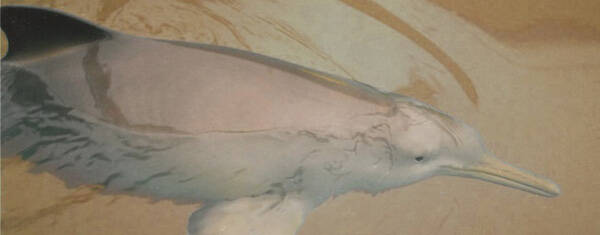Pontoporia blainvillei
IUCN
LCBasic Information
Scientific classification
- name:Pontoporia blainvillei
- Scientific Name:La Plata River Dolphin
- Outline:Cetacea
- Family:Pufferfish
Vital signs
- length:1.3-1.7m
- Weight:36-50kg
- lifetime:No verification information
Feature
It is the only freshwater dolphin that lives in the sea.
Distribution and Habitat
Known range: from the Stony River near Regencia, Brazil, southward through Uruguay to the Bay of Blanca, Argentina; southernmost occurrence may be on the northern coast of the Gulf of São Matísia, Argentina. Southernmost recorded occurrence is on the Valdés Peninsula, Argentina; however, it is now rarely seen. Most common on the Uruguayan side of the Rio de la Plata estuary; does not inhabit the river, and has never traveled upstream beyond Buenos Aires, Argentina. Very rare in winter, with a quasi-seasonal migratory behavior.
Appearance
The Lapu River dolphin is a freshwater dolphin with a fat head, straight lips, small and well-defined eyes, a crescent-shaped blowhole, some wrinkles on the neck, a gray-brown back, a blunt tip (with individual differences), a wide base, a dorsal fin that extends to the tail like a ridge, with the rear edge slightly concave inward, a slightly darker color around the eyes, and bones clearly visible through the skin, a wide pectoral fin that is almost triangular, with a strongly curved front edge and a serrated rear edge, a belly that gradually narrows toward the tail than the back, a very wide tail fin that can reach one-third of the body length, a long beak, and a more streamlined head.
Newborn dolphins are 70-80 cm long, and adult dolphins are 1.3-1.7 meters long. There are about 130 sharp teeth in the mouth, all of which are of the same type.
Details
The scientific name of the Lapu-Lapu river dolphin is Pontoporia blainvillei. It is the only freshwater dolphin that lives in the sea, but it prefers shallow coastal waters.

The pufferfish is a carnivore that often swims to the shallow water near the shore to hunt at dawn and dusk. It usually swallows freshwater fish less than 6.5 cm in length as a whole, and also eats a small amount of aquatic plants and insects. When breathing, the head comes out of the water first, then the whole body is exposed to the water surface, and after swimming 2 meters on the water surface, it enters the water again. The Lapu dolphin has almost zero vision and relies on echolocation to understand environmental changes. It has extensive scientific research value in biology, bionics and physiology. However, the Lapu dolphin is timid by nature and easily frightened. It usually stays away from ships and is difficult to approach. In addition, its population is small and its activity area is wide, so research on the Lapu dolphin in the wild is very limited.
The Lapu dolphin moves very slowly and basically does not roll or splash on the sea surface. When it surfaces to breathe, only a small part of its body is exposed; there are records of approaching small fishing boats, but it generally avoids boats. It will feed on or near the seabed, while looking for food, it also pulls out aquatic plants. It likes sandy land with undulating waves; on hot, sunny days, it can be found lying on the sandy land in very shallow waters to rest, and then intermittently surface to breathe. The breathing interval should be slightly longer than half a minute. When predators appear, especially sevengill sharks, the La River dolphin will stay at or near the surface of the sea, almost completely motionless. Observation records show that the La River dolphin usually lives alone, and there are also reports of groups of 5. Entanglement in fishing nets is the main cause of death for the La River dolphin, which has caused its population to drop sharply.
Like other freshwater dolphins, the La River dolphin has a small number of existing due to overhunting and environmental pollution. Over a long period of time, with the impact of human activities, its population has been declining and its distribution area has been gradually shrinking. Very few cases can be observed.
Although it is difficult to accurately estimate the population of the La River dolphin, it is considered the most threatened small cetacean in the southwest Atlantic and is rated Vulnerable (VU) by the IUCN. Although the population of La River dolphins is growing at a rate of 2% per year under human protection, this is not enough to make up for the 500 to 800 deaths each year. If a new ecological balance cannot be established as soon as possible, extinction will inevitably approach step by step. Nothing can compete head-on with the wheel of the human industrial age. Even a ghost with special skills can't escape death. We must continue to find and implement new protection measures for La River dolphins, and don't let the horn of the La Plata River play a lonely mourning.
Protect wild animals and eliminate game.
Maintaining ecological balance is everyone's responsibility!








